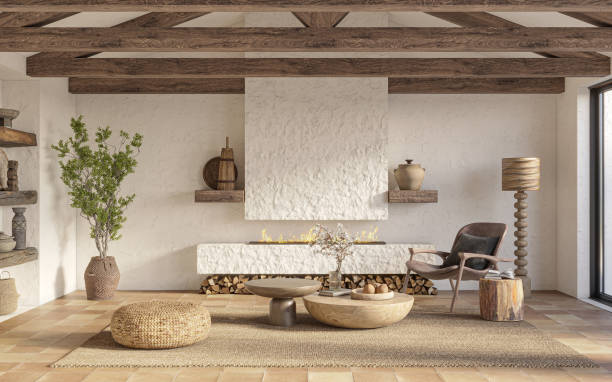Harmonizing Hygge and Wabi-Sabi: The Art of Imperfect Coziness
In the ever-evolving world of home design, a fascinating fusion is taking root. The Danish concept of hygge and the Japanese philosophy of wabi-sabi are intertwining to create spaces that are both comforting and thoughtfully imperfect. This blend of cozy contentment and rustic elegance is reshaping how we approach our living environments, offering a refreshing counterpoint to the polished perfection often sought in interior design.

The Roots of Hygge and Wabi-Sabi
Hygge, pronounced hoo-gah, emerged from Danish culture as a response to long, dark Scandinavian winters. It emphasizes creating a warm atmosphere and enjoying the good things in life with good people. The concept encompasses a feeling of cozy contentment and well-being through enjoying the simple things in life.
Wabi-sabi, on the other hand, is a Japanese worldview centered on the acceptance of transience and imperfection. The aesthetic is sometimes described as one of beauty that is imperfect, impermanent, and incomplete. It finds beauty in the flawed or aged, emphasizing simplicity, unaffectedness, and the integrity of natural objects and processes.
The Confluence of Comfort and Imperfection
The marriage of hygge and wabi-sabi in home design creates spaces that are simultaneously inviting and thought-provoking. This fusion encourages a lived-in feel, where the patina of use adds character rather than detracting from beauty. It’s about creating environments that tell a story, reflecting the passage of time and the experiences of those who inhabit them.
In practice, this might manifest as a cozy reading nook featuring a vintage chair with visible wear, adorned with a hand-knit throw blanket. The imperfections in the chair’s leather and the slight irregularities in the blanket’s stitching become points of interest rather than flaws to be hidden.
Materiality and Texture in Hygge-Wabi-Sabi Spaces
The hygge-wabi-sabi aesthetic places great emphasis on natural materials and rich textures. Wood, stone, and textiles like linen and wool take center stage, often in their raw or minimally processed forms. These materials are chosen not just for their visual appeal, but for how they feel and how they change over time.
Rough-hewn wooden beams, stone floors with visible fossils, and handwoven textiles all contribute to the sensory richness of these spaces. The goal is to create an environment that invites touch and interaction, fostering a deeper connection between inhabitants and their surroundings.
Color Palettes Inspired by Nature
The color schemes in hygge-wabi-sabi interiors are typically subdued and earthy, drawing inspiration from the natural world. Soft whites, warm greys, and muted earth tones dominate, creating a calming backdrop that allows textural elements to shine.
Pops of color, when used, are often derived from natural pigments or found in organic elements like plants or flowers. The overall effect is one of gentle harmony, mirroring the subtle color variations found in nature.
Embracing Weathering and Wear
Unlike design philosophies that prioritize newness and perfection, the hygge-wabi-sabi approach celebrates the marks of age and use. A well-loved wooden table with water rings and scratches, or a leather sofa that has softened and creased over years of use, are seen as more beautiful and valuable because of these imperfections.
This perspective encourages a more sustainable approach to home furnishings, valuing longevity and the stories objects accumulate over time. It’s a rejection of the throwaway culture, promoting instead a deeper appreciation for the things we choose to surround ourselves with.
Lighting for Atmosphere and Reflection
Lighting plays a crucial role in creating the hygge-wabi-sabi ambiance. Soft, warm lighting is preferred over harsh overhead fixtures. Candles, salt lamps, and string lights are often used to create a cozy glow that enhances the sense of comfort and intimacy.
Natural light is also highly valued, with window treatments designed to filter sunlight gently into spaces. The interplay of light and shadow is appreciated, with the changing qualities of natural light throughout the day adding to the dynamic nature of the space.
The Role of Nature and Organic Forms
Bringing elements of nature indoors is a key aspect of the hygge-wabi-sabi aesthetic. This goes beyond simply adding houseplants; it’s about incorporating organic forms and materials throughout the space. Driftwood sculptures, stones, and other found natural objects become focal points, blurring the line between indoor and outdoor environments.
The incorporation of plants is thoughtful and intentional, with a preference for species that have interesting textures or forms. A gnarled bonsai tree or a cascading string of pearls plant might be chosen for their unique character and the way they change over time.
Craftsmanship and the Human Touch
Handcrafted items play a significant role in hygge-wabi-sabi interiors. Whether it’s hand-thrown pottery, woven baskets, or artisanal furniture, these pieces bring a sense of authenticity and human connection to the space. The slight irregularities and imperfections in handmade objects are celebrated as evidence of the maker’s touch.
This emphasis on craftsmanship extends to the care and maintenance of the home itself. The act of tending to one’s space, whether through polishing wood, mending textiles, or arranging flowers, becomes a mindful practice that deepens the connection between inhabitant and environment.
Creating Personal Sanctuaries
Ultimately, the hygge-wabi-sabi approach to home design is about creating spaces that serve as personal sanctuaries. These interiors are designed to promote relaxation, reflection, and a sense of connection to oneself and others. They encourage a slower, more mindful way of living, where the beauty of everyday moments is recognized and celebrated.
By embracing both the cozy comfort of hygge and the wabi-sabi appreciation for imperfection, we can create homes that are not just visually appealing, but deeply nurturing to the soul. In a world that often feels chaotic and fast-paced, these hygge-wabi-sabi sanctuaries offer a much-needed respite, reminding us to find joy in simplicity and beauty in the imperfect.





